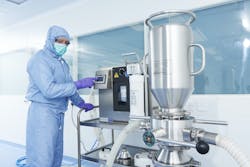It’s no secret that contaminants are the enemy of the cleanroom. When looking for equipment to use in a contained environment, manufacturers not only need to gauge function, they also need to work with products that are easy to keep free from impurities.
And although that goal is always top-of-mind, vendors have also found ways to go beyond products that keep work in a contained environment clean and have innovated a range of new options that help make it simple, as well.
Material matters
One of the keys to keeping a cleanroom up to code is locking contaminants out — which is why using doors that operate quickly can be a major advantage. Although stainless steel and fiberglass have been the go-to materials for making cleanroom doors, PVC offers the same benefits along with the ability to move at an unprecedented speed.
“New-age doors made from a heavy-duty 40-oz. PVC curtain can provide the same types of benefits as standard doors. The material is smooth enough to minimize harborage of dust and particulates, making it compliant with FDA and cGMP guidelines,” explains Jon Schumacher, director of marketing for Rite-Hite doors. “Light-weight fabric allows doors to open and close faster for maximum environmental control.”
Rite-Hite's SplitSecond Clean Pharmaceutical bi-parting door operates at an unprecedented peak speed.
Rite-Hite’s SplitSecond Clean Pharmaceutical bi-parting door hits a peak speed of 120” per second (3.05 m/sec) while providing a high level of environmental control and cleanliness in pharmaceutical operations. The door’s spring tube is designed to collect the curtain in the side frames and reduce overhead contaminants, while also taking up less wall space.
Combating residues
Making matters more complicated, the process of cleaning and disinfection in a controlled environment can also leave behind residues that create a new kind of contamination.
“Residues are a concern in pharmaceutical manufacturing, and companies have been cited for visual residues on surfaces in cleanrooms” Leslie Curry, vice president of Life Sciences Technical Consultants at Ecolab explains. “Additionally, [regulations] call out the need to manage these residues and consider their potential latent effects.”
Specifically, Curry says that the EU GMP Guidance Annex 1 draft “includes a statement for cleaning processes in the equipment section that cleaning processes should be validated that they can remove any residues that would otherwise create a barrier between the sterilizing agent and the equipment surfaces.”
To help meet these stricter requirements, Ecolab Life Sciences has developed an innovative method for residue measurement and comparison, including visual appearance, Residue on Evaporation (RoE) and residue accumulation. Ecolab says the three-phase approach demonstrates the differences between different products on both first and multiple further applications. According to the company, Ecolab Life Sciences’ range of low residue products offer cleanroom managers a less disruptive approach to controlling residues as part of the cleaning and disinfection process.
One cleanroom to the next
Many pharma companies today operate between different locations — posing a logistical challenge to transporting highly sensitive powder products between cleanrooms. Finding the right packaging is just one piece of the puzzle.
By monitoring usage and temperature, ChargePoint's VERIFI generates data that allows operators to easily manage their containment solution.
“Assuring the integrity of these expensive, sensitive powders whilst in transit is a challenge that is currently met with common packaging solutions that, while they meet the needs for transportation, often give facilities a headache when it comes to filling, sealing, handling and emptying in line with containment or sterility requirements,” says Ben Wylie, senior product manager, ChargePoint Technology. “One method that works well for facility A, may not work so well for facility B or vice versa.”
ChargePoint already offers a line of single-use products for secure powder transfer including split butterfly valves (SBVs). Now, the company is leveraging the power of data with its recently released VERIFI intelligent monitoring platform — the first technology of its kind — which monitors usage data for the company’s SBVs.
The company says that by recording how many times the valve has been used and monitoring its temperature, VERIFI generates data that allows operators and health and safety teams to manage the maintenance of their containment solution, which helps improve both safety and efficiency in pharma plants.


